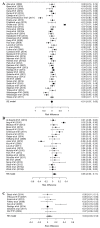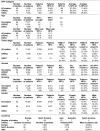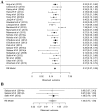Detection of HPV infection in head and neck cancers: Promise and pitfalls in the last ten years: A meta-analysis
- PMID: 30655973
- PMCID: PMC6313947
- DOI: 10.3892/mco.2018.1749
Detection of HPV infection in head and neck cancers: Promise and pitfalls in the last ten years: A meta-analysis
Abstract
The current controversial discussion on the disease-specific survival of patients with human papillomavirus (HPV)-positive (+) and -negative (-) squamous cell carcinoma (SCC) of the head neck region was the motivation for the present meta-analysis. Different detection methods for HPV are available, though these often lack sensitivity. As a consequence, there may be false interpretation of HPV positivity. A bias concerning HPV status and therefore also survival rates is serving a non-durable relevance in the discussion of tailored therapies. A literature search was performed via the online database PubMed/NCBI, and data extraction and statistical analysis were conducted. A total of 139 studies published between 2004 and 2014 were evaluated in the present meta-analysis. The HPV detection methods, patient characteristics, tumor localizations and stages, as well as (neo-) adjuvant therapies and survival times were analyzed. The average incidence rates of HPV+ patients with oropharyngeal tumors were higher than those of patients with cancers of other regions of the head and neck. Upon evaluating the results of different detection methods no significant differences were identified. We have compared the HPV incidence rates of each detection method, when studies have used more than one. Regarding overall survival, the pooled adjusted hazard ratio (HR) for oropharyngeal SCC was 0.31 [95% confidence interval (CI)=0.27-0.36]. Unfortunately, only 3 equivalent studies were available on nonoropharyngeal tumors, for which the pooled adjusted HR was 1 (95% CI=0.73-1.36). Overall, the evaluation demonstrated that the survival rates reported in numerous studies were not evaluated multifactorially and important confounders were excluded from the statistics. The HPV detection methods used were often not sufficient in representing HPV positivity. In addition, oropharyngeal and oral SCCs were assessed together in the localization. The widely differing number of HPV+ patients in each of the various studies may be explained by insufficient detection methods and by a lack of localization distinction. The considerations of a tailored therapy according to HPV status should be rejected based on the present information. The previously published studies should be read critically and do not represent a basis for therapeutic decisions.
Keywords: detection methods; human papillomavirus; oropharyngeal squamous cell carcinoma; survival.
Figures




References
-
- Kaatsch P, Spix C, Katalinic A, Hentschel S, Luttmann S, Stegmaier C. Robert-Koch-Institut; Berlin: 2015. Cancer in Germany 2011/2012. Robert Koch Institute and the Society of Epidemiological Cancer Registries in Germany. (In German)
LinkOut - more resources
Full Text Sources
Molecular Biology Databases
Research Materials
